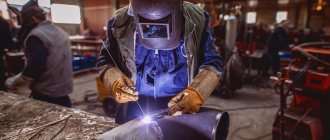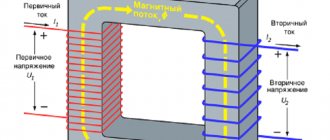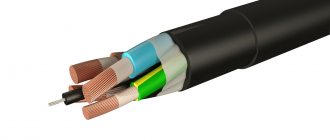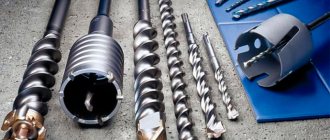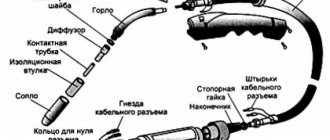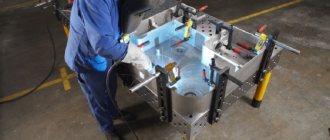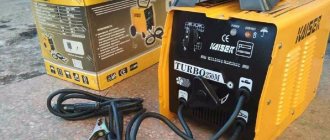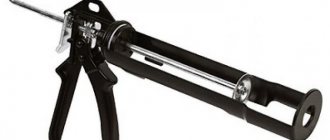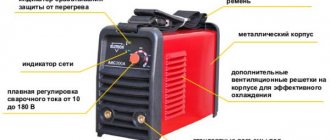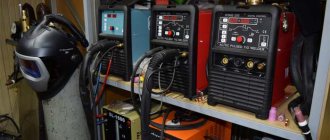An electrode holder for MMA welding is a device designed to hold a piece electrode and supply electric current to it.
Good electrode holder:
- provides reliable fastening of the electrode and the ability to quickly change the exit angle of the electrode;
- guarantees full electrical contact;
- ensures quick replacement of the electrode.
- lightness is not the last parameter that you need to pay attention to. At the end of the working day, with a heavy electrode holder, your hands will fall off.
Normal weight is from 350 grams for a current of 125A to 750 grams for a current of 500A.
Helpful advice: you should not buy an electrode holder with a power reserve, based on the common misconception that it will last longer. In fact, professional electrode holders can exactly withstand the load they claim, but only if you purchased a branded product.
The most common types of electrode holders:
- spring;
- screw (or clamp)
The most popular at present are universal electrode holders, which, thanks to a spring-loaded clamping mechanism and specially designed brass or copper jaws, allow the electrode to be placed in various spatial positions. The welding holder body, handle and moving parts must be made of high-quality insulating and heat-insulating materials. It can be plastic or ceramic plastic.
Due to the large influx of low-quality products from China into the welding equipment markets, when purchasing an electrical holder, it is recommended to check its current-carrying parts with a magnet. It often happens that they are made of steel, on the surface of which there is a copper-like coating. It is recommended to subject the grounding terminals to the same magnetic testing procedure, so as not to end up with a device that will quickly overheat and burn out during welding.
Beginners in welding often ask the question: why buy a new electric holder if, when purchasing a welding inverter, everything necessary for welding is already included with it?
KV-200
The answer is very simple: often, the electric holder that comes with the welding machine quickly breaks down, regardless of whether you use it in production or occasionally cook at home. Usually this is the KV-200 model. Due to the fact that cheap materials are used for its manufacture, the first thing that fails is the pressing jaws, which burn and do not provide reliable fixation. The electrode begins to dangle, which gets on the welder’s nerves and affects the quality of the welds.
By the way, the quality of other components, especially when it comes to cheap welding machines for home welding such as Resanta, Svarog, Fubag, etc., as a rule, leaves much to be desired. This applies to both the ground terminal and welding cables. Resanta's cable is completely aluminum, which may look fantastic, but it really is. The cunning Chinese put a copper coating of several microns on it so that when you remove the insulation, the forgery will not be visible, but this should not mislead you. Make a notch with a knife and you will see that there is light metal in the core. Questions also arise about the length of the cables and their rigidity. But this is a topic for a separate article. It is better to buy all components separately.
Types of welding holders
Depending on the area of application, electrode holders can be divided into two large groups - universal and specialized. The use of specialized fasteners is regulated by the relevant GOSTs; their use in publicly accessible areas is quite limited. Universal holders are structurally divided into five groups:
- electrode holders – “clothespins”;
- electrode holders – “tridents” or “forks”;
- collet electrode holders;
- non-burning electrode holders;
- threaded electrode holders.
Electrode holders for welding machine
Holders – “clothespins”
The electrodes are secured in holders of this type using a spring or lever clamping mechanism. These models are made with a reliable heat-resistant dielectric coating, which guarantees the safety of the welder and eliminates unauthorized sparking. The contact surfaces have a toothed structure, which allows you to quickly and reliably secure the rod as needed for work.
The main advantages of holders of this type are simplicity of design, availability and low cost. With the help of such holders you can obtain high quality seams. Thanks to the correct positioning of the welding rod, rapid ignition of the arc is ensured. The disadvantages of clamps of this type include the low reliability of fixing the rod when the spring-loaded lever is loosened.
“Fork” holders
This welding machine holder is the most popular electrode holder model among professional welders. It is a structure consisting of three steel rods welded together, and the rods are welded so that the middle one acts as a spring, pressing the rod against the other two. Due to its simplicity, such a clamp has a low degree of protection, since a significant part of it is energized.
In addition to the presence of unprotected surfaces, the disadvantages of such clamps include the difficulty of removing the cinder, and in addition, they are not very convenient to use.
Collet type welding fixtures
Collet-type welding electrode holders are a rather complex design. The rod clamp in these devices is made on the same principle as the drill clamp in a hand drill. It is very difficult to make such a clamp yourself; this will require the use of professional equipment - lathe, milling, drilling machines. In addition, very high precision machining of parts is required.
Electrode holders - device
Collet-type electrode holders are used in torches in the argon-arc process - welding in an argon inert gas environment.
Non-burning holders
The flameless holder for a welding machine has the simplest design of all electrode holders. It consists of only two parts - a handle with a current-insulating coating and a current-carrying rod. The electrode in such a holder is not fixed by any clamping devices, but is welded to the end end of the contact rod. During operation, the electrode melts without any residue, after which the next one is welded to the rod.
Such welding electrode holders are used when working with expensive consumables.
Design diagrams of electrode holders for manual arc welding
Threaded or screw holders
The screw welding holder is the most popular among welders. Due to the fact that pressing is carried out by screwing the clamping head, reliable fixation of the rod in the device is ensured. Equipped with an ergonomic handle made of dense dielectric, a dielectric screw-down clamping head, this electrode holder does not have exposed live parts, which is a guarantee of safety for the welder.
Screw electrode holder
These devices are available in several modifications:
- straight, with right-hand thread;
- straight with left-hand thread;
- curved with right-hand thread;
- curved with left-hand thread.
Specialized holders
Electrode holders of specialized models are designed to work in specific devices for the unique welding of certain products with special types of seams. One such device is a specialized welding unit that performs simultaneous welding with several rods. Specialized holders also work in machines for three-phase arc welding. All these models have a very complex design and are quite heavy for manual work.
Three-phase arc welding
Let's get down to specifics...
Brands that are trusted by welders:
- The well-known German company ABICOR BINZEL. It is primarily known for its argon arc welding torches, which are widely used. For manual arc welding, BINZEL has a simple assortment of four models of spring-type electrode holders DE 2200, DE 2300, DE 2400, DE 2500 “KURT HAUFE”, similar to each other like two drops of water and differing only in current strength (from 200 to 600A) , respectively, by weight and dimensions. They are reliable, made of high-quality materials that provide the necessary mechanical and thermal properties and provide fixation of the electrode in four positions. The KURT HAUFE series is very popular in the welding market, so be careful!
- Swedish industrial company Esab . Eco Handy, PRIMA series. The screw-type electrode holder provides more reliable fastening of the electrode. It is fixed in the mounting holes without play: in the 90 degree position in the end hole and in the 90 and 45 degree position in the hole located on the diameter.
Minus: the electrode holder is a bit heavy, but this is its only drawback. Included: a powerful hexagon and a copper plate with which the cable is wrapped and crimped.
- Telwin . They are cheaper than previous brands, although sellers position them as Italy. But we know where they make products that cost less. Although the quality is acceptable. There are high-quality insulators that do not burn even at currents of more than 300A during prolonged operation, the fastenings do not loosen. Of the minuses: heavier than the same ABICOR BINZEL
- Eagle/Falcon electrode holders . From Trafimet, Italy. In our humble opinion, he is one of the best representatives of his species. There are no complaints about the fittings and fastenings. A definite plus: light weight, fits comfortably in the hand.
Basic technical data of electrode holders
When purchasing electrode holders, you should take into account what kind of work will be performed by the welding machine, what the power of the latter is, and what electrodes will be used during welding. Main technical characteristics that you should pay attention to when purchasing a holder:
Electrode holder Parva 2
- fastening type;
- fixation angle;
- electrode diameter;
- welding current;
- cable section;
- device weight.
The larger the cable cross-section, the higher the welding current, the larger the electrode diameter can be. But such holders also weigh more. For example, the “Superior 6” fixed-angle screw type clamp is designed for electrodes with a diameter of 4.0 mm to 6.3 mm, a cable with a cross-section of up to 70 mm2 and a current of up to 400 amperes. The weight of the device is 690 grams.
The spring-type holder “Parva 2” is designed for installation of electrodes with a diameter from 2.0 mm to 3.2 mm at any angle; a cable with a cross-section of up to 25 mm2 is connected to it, carrying a current of up to 200 amperes. The device weighs only 325 grams.
How to choose an electrode holder
The safety of the welder and the quality of the seam depend on the features of the electrode holder for the welding machine. It is necessary to first study its technical capabilities. The holder must be suitable for the welding model and can withstand the current used in the equipment.
A holder with a lower current-carrying capacity in a powerful welding machine is dangerous to life!
By power
It is recommended to select a model in accordance with the required current name. If the device is selected with a small power reserve, it will not be suitable in all situations. The current rating is indicated in the marking, which is located on the stationary part of the device.
During long-term welding, an overly powerful holder is inconvenient to use due to its increased dimensions and weight. Excess weight will affect the quality of the seam. Heaviness causes muscle strain, and the hand will get tired with prolonged use.
In work that requires special precision and accuracy, it will be difficult to lay a high-quality seam. If a working tool with the same power rating differs in weight, it is better to prefer a lighter design with small dimensions.
By type of design
The handle of the holder must be made of high-quality dielectric. Linings made of thick dielectric plastic, resistant to elevated temperatures, are used as insulation.
The device must have a high reliability class, withstand temperature changes and various contaminations. Craftsmen prefer to choose varieties with a massive cast clamp. Experts say that plate devices are less wear-resistant.
An electrode holder for a DIY welding machine is suitable for use, provided that it meets safety requirements. Collet devices with threaded or clamping fastening are considered optimal.
Threaded models allow adjustment of the electrode angle. It should be borne in mind that a homemade trident for welding is the most dangerous device due to the high probability of electric shock to the welder. The cinder is difficult to remove from the fork, and the seams are of poor quality.
Rating of the best holders
When choosing a clamp for welding, you should rely on reviews from professional welders. Chinese analogues are of poor quality. Most of the negative reviews are associated with them. The ranking of the best models of foreign and domestic production includes:
- ESAB Handy 200 (200 A) - a Swedish device with a screw fastening, supports the installation of electrodes with a cross-section of 2-4 mm;
- Sibrteh 500A – domestic clamp with a high-quality plastic dielectric on the handle;
- ESAB 500 - a Swedish tool with minimal weight, designed for currents up to 500 A ;
- Germany type 300 A – equipped with a knurled handle for easy welding, the brass body is corrosion resistant.
It should be remembered that inexpensive devices are not inferior in capabilities to branded analogues. They are quite suitable for short-term welding or one-time welding. For long-term use at home, it is advisable to choose devices in the mid-price segment.
Expensive branded models are suitable for specialists involved in professional welding. They are designed for long-term and increased loads. For frequent use on the road, it is recommended to have a spare holder that can help out if the one used in the work breaks down.
If the holder is selected correctly, working with the tool will be comfortable, and the seams will be of high quality.
DIY welding holder
The design of some models of holders is so simple that many craftsmen prefer not to buy them, but to make these devices themselves. We are talking about fork-type holders. Such holders are considered classics in welding, and their production takes literally a matter of minutes.
Homemade electrode holder - diagram
To make such a holder, you will need one rod of corrugated fittings one meter long, a piece of thick rubber hose (as an option - a bicycle handlebar handle), an M10 bolt with two washers and nuts. The reinforcement rod is cut into three dimensional pieces, and one piece should be slightly longer than the other two. A bolt is welded to it, with the thread facing outward, and then the two remaining pieces, so that a trident is formed.
A rubber hose is pulled onto the structure from the bolt side. A washer is put on the bolt, the cable is connected, then a second washer is put on, secured with a nut and locked with a second nut. The teeth of the “fork” are cleaned with a file to ensure better contact with the electrode. The holder is ready for use. Its disadvantage will be poor protection of the welder from current-carrying parts, difficulty in removing the cinder, and oxidation of the reinforcement.
Some craftsmen use a steel angle instead of reinforcement, and as a pressing element they independently make a two-turn spring, which ensures reliable fixation of the rod. Small cuts can be made on the edges of the angle to install the electrodes at different angles.
DIY electrode holder
Holder "Trident"
When raising such a topic, it is very difficult to ignore the “trident” option, which every self-respecting welder assembles for himself. Its design is simple and uncomplicated, so it is difficult to resist the temptation to make it with your own hands, some kind of creativity, to which, undoubtedly, the soul of every real welder lies. At the same time, you will be able to independently evaluate all the pros and cons of a homemade holder, and you will only have yourself to blame for poor quality assembly. This folk art is also suitable for those who do not like factory holders.
There are many assembly methods. Let us present the simplest of them.
The body of the holder (trident) is made by bending reinforcement (or rod) made of carbon steel with a diameter of 8 mm (6 mm is possible, but it burns out quickly, you can take a diameter >8 mm). As experience shows, eight lasts longer and is more convenient to work with.
Next, a tube is made like a terminal, divided into two parts, one part crimps the cable, stripped of insulation, the second holds the cable insulation. All this is welded to the trident. This operation is the most critical, since unreliable contact leads to heating. The insulator (for example, a piece of reinforced hose) is put on hot. To prevent the insulator from loosening, you can use, for example, Done Deal, a high-strength anaerobic thread locker.
Holder "Corner"
It has a similar design to a trident; why it is called that is clearly visible in the photo. Disadvantage: in the trident, all the clamps are spring-loaded, but in the angle version, the entire load falls on one central rod.
Plus: no need to hit or scratch, the electrode is removed with the next electrode and you always know where it will fly.
“Trident” VS factory electric holder
According to some welders, a more reliable holder simply does not exist. Others prefer to keep up with the times and purchase a factory holder. Let's try to compare them and come to a common opinion, which is better for welding?
Advantages of a homemade holder:
- Minimum manufacturing costs;
- Does not require careful handling and is not afraid of falls from a height;
- If you have to weld painted metal and there is no way to clean it, for example, with a grinder, then this can easily be done with the holder itself.
Flaws:
- Prohibited due to industrial safety regulations;
It is clear that no one will inspect us what kind of holder we use, however, this gives us something to think about, since due to its bareness there is a high probability of electric shock, especially in damp weather or when working with wet metal.
- The design limits the options for attaching the electrode because sometimes you have to clamp the electrode strictly vertically in order to reach hard-to-reach places;
- Replacing the cinder in a trident also leaves much to be desired, since in some cases it is even dangerous (when you knock out the electrode, you don’t know where it can fly - it can easily hit the eye);
- There is a high probability of shorting on the structure. This is especially tragic when repairing structures sheathed with corrugated sheets. The slightest touch of the electrode holder on the corrugated sheet will result in an instant burn, which will ruin the appearance.
